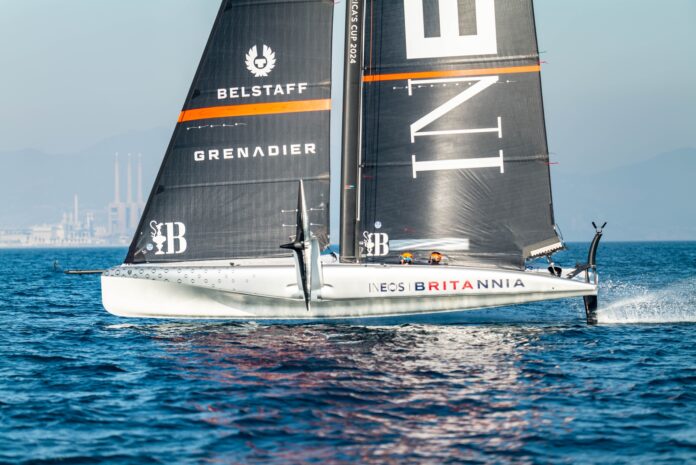Flat water and a light sea-breeze gave INEOS Britannia a perfect blank canvas in Barcelona today to start digging into a conundrum that’s bothered the team since the arrival of their second AC40 for the two-boat race practise programme. What’s been spotted but not publicly acknowledged until today is the very slight speed differential that the new boat has over the AC40 that the team used in the two Preliminary Regattas in 2023.

Today, in marginal, lower-end test conditions, it was again ‘Boat B’ – or ‘Sienna’ – that held the upper hand with Sir Ben Ainslie and Giles Scott winning most of the pre-starts and speed tests over what appeared to be a marginally horsepower-struggling ‘Boat A’ with Dylan Fletcher-Scott and Ben Cornish driving.
The team were trialling a new triangular topped, low aspect J2 jib that they switched between boats with little difference spotted by the recon team and Ben acknowledged the speed issue in interview afterwards saying: “We are seeing a little bit of difference between the boats which is interesting from a one-design class perspective but yeah I think we need more time with this other headsail to figure out how it’s going, we switched it between boats but it’s hard to tell really…we’re trying to figure out what’s causing that difference so we’re lining up the boats and making sure that everything is symmetric in terms of foil arm positions, rig and the systems on the boat to see if there’s any differences there. For us it’s really important to try and figure out what’s making that difference because that will help us understand these boats in general.”

And Ben, also wryly commented: “I think we’re seeing that ‘Boat B’ is just a click faster than ‘Boat A’ so yeah, I guess I wish we had ‘Boat B’ earlier in the year.” The mystery of the speed differential is something that this highly technical, data-driven team will, for sure, get to the bottom of and the results could be extremely important to their overall campaign.
Speaking about the new J2 headsail, Ben also made a very interesting comment that alluded to perhaps how prized the team might favour manoeuvrability over outright speed in the AC75 in a very tight Challenger Series, as he said: “It’s also about the functionality of the sails as well. We know here in Barcelona that it’s very variable conditions so you kind of want sails that are going to give you that variability, that ability to adapt to conditions, and mode changes, so there’s maybe more to it than just straight-line speed.” Interesting period for INEOS Britannia with plenty of learning going on all round and plenty for the Mercedes Applied Science analysts to dig into back at ‘Mission Control.’
On-Water Recon Report – INEOS Britannia: Team IB craned to the water their two AC40s, Sienna(b) and Athena(a), at 09.54am and 10.08am, respectively, in one-design foil configuration. Both boats had been left out of the shed with their masts up overnight. The team docked out just after 12:00, as planned.

At 12:10 one-design mainsails and J1s were hoisted while exiting the port. However, the wind intensity was not strong enough to start the training, reason why the team was forced to wait for approximately one hour and a half just outside the harbour.
At 13:45 finally the south-westerly sea-breeze kicked in, allowing the session to begin. Both boats headed towards the racing area, were an upwind-downwind course was set.
Four, one-lap, upwind-downwind races were carried out in marginal 5 to 8 knots conditions, with each boat executing three to four tacks and gybes per leg, respectively. The two boats alternated the starboard and port entries. AC40(b) had a solid performance, starting ahead, rounding the top marks ahead, and winning the four races.
Race two was the closest one, in which both boats rounded the bottom gates almost at the same time. Race four was also close, with AC40(a) finishing less than 10 seconds behind.
After the fourth race at 15:15, the J1s were replaced by a one-design J2 onboard AC40(b) and by the new LEQ12_J2-4 on AC40(a). Ten minutes after, both boats started to speed test upwind. One long upwind and downwind were carried out, on both tacks, with both boats switching sides. Differences were small, however, AC40(b) using the one-design J2 was slightly faster both upwind and downwind, with a greater margin on the downwind.
At 16:10 both jibs were lowered and then switched. AC40(a) hoisted the one-design J2, while AC40(b) put the new LEQ12_J2-4 probably to test and eliminate any possible human and boat bias. On the upwinds AC40(b) continued to seem to have something extra. However, differences were smaller than before switching jibs. On the downwind and specially on port tack, AC40(a) with the one-design jib was slightly faster.
Just before entering the port, both boats headed back to the racecourse area and did one more start and race, possibly to test differences in performance in between both jibs while manoeuvring during the pre-start. All these in bottom range J2 conditions.
At 17:20 AC40(b) entered the port and started to drop both sails. AC40(a) followed ten minutes after. By 17:50 both boats were on the dock, and at 18:00 AC40(b) was the first of the two boats to be craned out of the water indicating the end of the day. Sebastian Peri Brusa – Recon on INEOS Britannia






